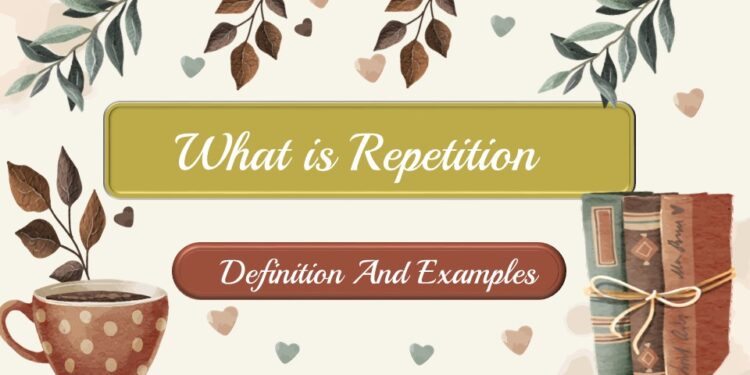What is Repetition Definition And Examples
Repetition is a literary device that involves the deliberate use of words, phrases, or sounds for emphasis or effect. It is a powerful technique employed by writers and speakers to reinforce ideas, create rhythm, and enhance the overall impact of their message. By repeating certain elements, writers can draw attention to key concepts, make them more memorable, and engage their audience or readers in a more impactful way.
Repetition is a fundamental aspect of human communication and has been employed in various forms of art and literature throughout history. From ancient poetry to modern speeches, repetition has played a significant role in capturing attention, conveying meaning, and evoking emotions. Its effectiveness lies in its ability to create patterns, establish connections, and reinforce important ideas.
Also Read-
- What is Protagonist Definition And Examples
- What is Plot Definition And Examples
- What is Pathos Definition And Examples
One of the primary functions of repetition is to emphasize and reinforce key points or themes. What is Repetition Definition And Examples By repeating certain words or phrases, writers can make them stand out and resonate with the audience. What is Repetition Definition And Examples This technique is particularly useful when conveying important information, expressing strong emotions, or making persuasive arguments. What is Repetition Definition And Examples Through repetition, writers can ensure that their intended message is understood and remembered by the reader or listener.
Repetition can take various forms depending on the writer’s purpose and the context of the writing. Some common types of repetition include:
- Word Repetition: This involves repeating a specific word or words to highlight their significance or to create a particular effect. By repeating a word, writers can draw attention to its meaning or evoke a specific image or feeling.
Example: “Never, never, never give up.” – Winston Churchill
- Phrase Repetition: This involves repeating a group of words or a phrase to reinforce its importance or to create a rhythmic pattern. What is Repetition Definition And Examples Phrase repetition can create a memorable cadence in a piece of writing and contribute to its overall flow and musicality.
Example: “I have a dream” – Martin Luther King Jr.’s famous speech
- Structural Repetition: This involves repeating a specific structure or pattern in a piece of writing. It can be in the form of repeating sentence structures, parallelism, or the repetition of entire lines or stanzas. What is Repetition Definition And Examples Structural repetition adds coherence and unity to the writing, making it more engaging and impactful.
Example: “To err is human, to forgive divine.” – Alexander Pope
- Sound Repetition: This involves repeating certain sounds, such as consonants or vowels, to create a specific auditory effect. What is Repetition Definition And Examples Sound repetition can contribute to the musicality of a piece and add a sense of rhythm or harmony.
Example: “The fair breeze blew, the white foam flew.” – Samuel Taylor Coleridge
Repetition serves multiple purposes in literature and writing. What is Repetition Definition And Examples It can create a sense of rhythm, establish patterns, evoke emotions, enhance clarity, and reinforce important ideas. However, it is important to use repetition judiciously and purposefully. What is Repetition Definition And Examples Overusing repetition can lead to monotony and dilute its impact. Therefore, writers must carefully consider when and how to employ repetition to achieve the desired effect.
Conclusion
Repetition is a versatile and powerful literary device that can greatly enhance the impact and effectiveness of a piece of writing. What is Repetition Definition And Examples By deliberately using repeated words, phrases, sounds, or structures, writers can emphasize key points, create rhythm, and engage their audience or readers in a more profound way. What is Repetition Definition And Examples Whether it is through the repetition of specific words for emphasis, the repetition of phrases to establish a rhythmic pattern, or the repetition of sounds to add musicality, repetition adds depth and resonance to writing. What is Repetition Definition And Examples However, it is important to use repetition judiciously and purposefully, as overusing it can lead to monotony or dilute its impact. By understanding the different forms and purposes of repetition, writers can harness its power to convey their message with greater clarity and resonance.
FAQ.
Q. Why is repetition used in writing?
Ans. Repetition is used in writing to emphasize key points or themes, create rhythm and musicality, and engage the audience or readers. It helps to reinforce important ideas, make them more memorable, and evoke emotions. Repetition adds structure and cohesion to writing, allowing for a more impactful and engaging reading experience.
Q. What is the difference between repetition and redundancy?
Ans. Repetition involves the deliberate use of repeated words, phrases, sounds, or structures for emphasis or effect. It is purposeful and adds meaning and impact to the writing. Redundancy, on the other hand, refers to unnecessary repetition or duplication of information. Redundancy can weaken the writing by adding unnecessary bulk or stating the same point multiple times without adding new insights.
Q. Can repetition be used in different types of writing?
Ans. Yes, repetition can be used in various forms of writing, including poetry, prose, speeches, essays, and storytelling. It is a versatile literary device that can be adapted to different genres and styles of writing. The specific use and effect of repetition may vary depending on the context and purpose of the writing.
Q. How can repetition enhance the clarity of a message?
Ans. Repetition can enhance the clarity of a message by emphasizing important ideas or concepts. By repeating key words or phrases, writers ensure that those points stand out and are easily understood and remembered by the audience or readers. Repetition can also help to establish a clear and coherent structure in the writing, making the message more accessible and comprehensible.
Q. Is there a risk of overusing repetition?
Ans. Yes, overusing repetition can diminish its impact and lead to monotony or reader fatigue. It is important to use repetition judiciously and purposefully, ensuring that it serves the intended effect without becoming excessive. Writers should strike a balance between repetition and variety to maintain reader engagement and avoid redundancy.
Q. Can repetition be translated effectively in different languages?
Ans. Translating repetition can be a challenge as it involves not only conveying the meaning but also preserving the intended effect and impact. Translators need to carefully consider the cultural and linguistic nuances of both languages to maintain the rhythm, musicality, and emphasis of the repeated elements.

















